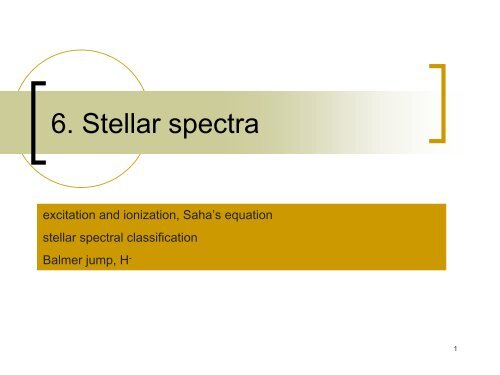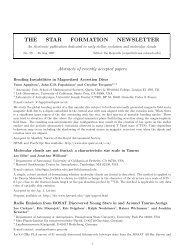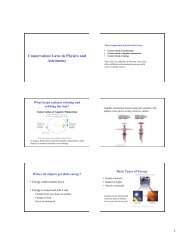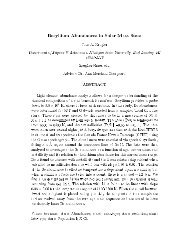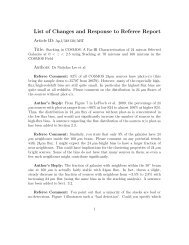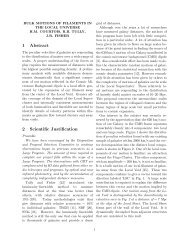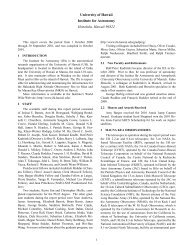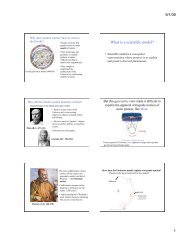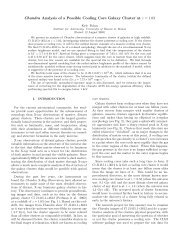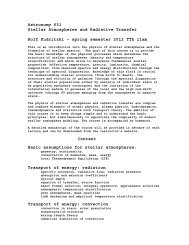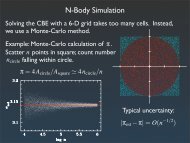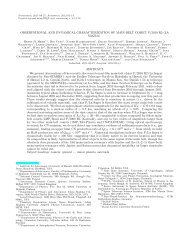6. Stellar Spectra
6. Stellar Spectra
6. Stellar Spectra
You also want an ePaper? Increase the reach of your titles
YUMPU automatically turns print PDFs into web optimized ePapers that Google loves.
<strong>6.</strong> <strong>Stellar</strong> spectra<br />
excitation and ionization, Saha’s equation<br />
stellar spectral classification<br />
Balmer jump, H -<br />
1
Occupation numbers: LTE case<br />
Absorption coefficient: <br />
= n i<br />
<br />
calculation of occupation numbers needed<br />
LTE<br />
each volume element in thermodynamic equilibrium at temperature T(r)<br />
hypothesis: electron-ion collisions adjust equilibrium<br />
difficulty: interaction with non-local photons<br />
LTE is valid if effect of photons is small or radiation field is described by<br />
Planck function at T(r)<br />
otherwise: non-LTE<br />
2
Excitation in LTE<br />
Boltzmann excitation equation<br />
n ij : number density of atoms in excited level i of ionization stage j<br />
(ground level: i=1 neutral: j=0)<br />
n ij<br />
n 1j<br />
= g ij<br />
g 1j<br />
e −E ij/kT<br />
g ij : statistical weight of level i = number of degenerate states<br />
E ij excitation energy relative to ground state<br />
g ij = 2i 2 for hydrogen<br />
= (2S+1) (2L+1) in L-S coupling<br />
log n ij<br />
=log g ij<br />
− E ij (eV) 5040<br />
n 1j g 1j T<br />
The fraction relative to the total number of atoms of in ionization stage j is<br />
n ij<br />
n j<br />
= g ij<br />
U j (T) e−E ij/kT<br />
U j (T )= X i<br />
g ij e −E ij/kT<br />
U j<br />
(T) is called the<br />
partition function<br />
3
Ionization in LTE: Saha’s formula<br />
Generalize Boltzmann equation for ratio of two contiguous ionic species j and j+1<br />
Consider ionization process j j+1<br />
initial state:<br />
final state:<br />
n 1j & statistical weight g 1j<br />
n 1j+1 + free electron & statistical weight g 1j+1 g El<br />
n 1j+1 (v) dx dy dz dp x dp y dp z<br />
R R<br />
n1j+1 (v)dV d 3 p = n 1j+1<br />
number of ions in groundstate with free electron with velocity in (v,v+dv) in phase space<br />
g El : volume in phase space normalized to smallest possible volume (h 3 ) for electron:<br />
g El =2 dx dy dz dp x dp y dp z<br />
h 3<br />
2 spin orientations<br />
R<br />
dx dy dz =<br />
R<br />
dV = ∆V =1/ne<br />
dp x dp y dp z =4πp 2 dp =4πm 3 v 2 dv<br />
4
Ionization: Saha’s formula<br />
n 1j+1 (v)<br />
dV dp x dp y dp z = g 1j+1<br />
g El e −(E j + 1 2 mv 2 )/kT<br />
n 1j g 1j<br />
using Boltzmann formula<br />
n 1j+1 (v)<br />
dV dp x dp y dp z = g 1j+1<br />
2dV dp x dp y dp z<br />
e −[E j+ 1<br />
n 1j g 1j h 3 2m (p 2 x +p2 y +p2 z )]/kT<br />
Sum over all final states: integrate over all phase space<br />
n 1j+1 = n 1j<br />
g 1j+1<br />
g 1j<br />
2 ∆V<br />
h 3<br />
e −E j/kT<br />
Z ∞<br />
Z ∞<br />
Z ∞<br />
−∞ −∞ −∞<br />
e − 1<br />
2mkT (p2 x +p2 y +p2 z ) dp x dp y dp z<br />
Z∞<br />
−∞<br />
e −x2 dx = √ π<br />
(2πmkT ) 3/ 2<br />
Saha 1920<br />
n 1j+1 n e<br />
n 1j<br />
=2 g 1j+1<br />
g 1j<br />
µ 2π mkT<br />
h 2<br />
3/ 2<br />
e − E j<br />
kT<br />
- ionization falls with n e<br />
(recombinations)<br />
- ionization grows with T<br />
5
Ionization: Saha’s formula<br />
Generalize for arbitrary levels (not just ground state):<br />
n j =<br />
∞X<br />
n ij n j+1 =<br />
i=1<br />
∞X<br />
i=1<br />
n ij+1<br />
n ij+1 = n 1j+1<br />
g ij+1<br />
g 1j+1<br />
e −E ij+1/kT<br />
using Boltzmann’s equation<br />
n j+1 = n 1j+1<br />
g 1j+1<br />
∞ X<br />
i=1<br />
g ij+1 e −E ij+1/kT<br />
U j+1 (T) :<br />
partition function<br />
also<br />
n j = n 1j<br />
g 1j<br />
U j (T) n j+1 n e<br />
n j<br />
=2 U j+1(T)<br />
U j (T)<br />
µ 2πmkT<br />
h 2<br />
3/2<br />
e − E j<br />
kT<br />
6
Ionization: Saha’s formula<br />
Using electron pressure P e instead of n e (P e = n e kT)<br />
n j+1<br />
n j<br />
P e =2 U j+1(T)<br />
U j (T)<br />
µ 2πm<br />
h 2<br />
3/ 2<br />
(kT) 5/2 e − E j<br />
kT<br />
which can be written as:<br />
n<br />
log j+1<br />
U<br />
10 = −0.1761 −log 10 P e +log j+1 (T )<br />
10<br />
n j U j (T )<br />
+2.5log 10 T − 5040<br />
T<br />
E j<br />
with P e in dyne/cm 2 and E j in eV<br />
7
Ionization: Saha’s formula<br />
Example: H at P e = 10 dyne/cm 2 (~ solar pressure at T = T eff )<br />
T (K) n(H + ) / n(H) n(H) /[n(H) + n(H + )] n(H + ) /[n(H) + n(H + )]<br />
4,000 2.46E-10 1.000 0.246E-9<br />
6,000 3.50E-4 1.000 0.350E-3<br />
8,000 5.15E-1 0.660 0.340<br />
10,000 4.66E+1 0.021 0.979<br />
12,000 1.02E+3 0.000978 0.999<br />
14,000 9.82E+3 0.000102 1.000<br />
16,000 5.61E+4 0.178E-4 1.000<br />
H fractional ionization<br />
1.2<br />
1<br />
0.8<br />
0.6<br />
0.4<br />
0.2<br />
0<br />
4000<br />
6000<br />
H I<br />
8000<br />
10000<br />
H II<br />
Temperature<br />
12000<br />
14000<br />
16000<br />
18000<br />
20000<br />
8
On the partition function<br />
Partition function for neutral H atom<br />
E i0 ≤ E ion = 13.6 eV<br />
U 0 (T)=<br />
∞X<br />
g i0 e −E i0/kT<br />
i=1<br />
g i0 = 2i 2<br />
U 0 (T ) ≥ 2 e −E ion /kT<br />
infinite number of levels partition function diverges!<br />
reason: Hydrogen atom level structure<br />
∞X<br />
i 2 calculated as if it were alone in the universe<br />
not realistic cut-off needed<br />
i=1<br />
divergent<br />
idea: orbit radius r = a 0 i 2 (i is main quantum number)<br />
there must be a max i corresponding<br />
to the finite spatial extent of atom r max<br />
4π<br />
3 r3 max = 1 N = 4π 3 (r 0i 2 max) 3 i max<br />
introduces a pressure<br />
dependence of U<br />
9
An example: pure hydrogen atmosphere in LTE<br />
Temperature T and total particle density N given: calculate n e , n p , n i<br />
N = n e + n p +<br />
iX<br />
max<br />
i=1<br />
iX<br />
max<br />
n i = n e + n p + n 1<br />
i=1<br />
g i<br />
g 1<br />
e −E i,1/kT<br />
From Saha’s equation and n e = n p (only for pure H plasma):<br />
n p n e<br />
n 1<br />
=2 g µ 3/2<br />
p 2πmkT<br />
e − E ion<br />
g 1 h 2<br />
kT<br />
g p =1 g 1 =2<br />
n 1 = n 2 e<br />
µ<br />
h<br />
2<br />
2πmkT<br />
3/2<br />
e E ion<br />
kT<br />
N =2n e + n 2 e<br />
µ h<br />
2<br />
2πmkT<br />
3/2<br />
e E ion<br />
kT<br />
iX<br />
max<br />
i=1<br />
i 2 e −E i,1/kT =2n e + n 2 e α(T)<br />
(T)<br />
n e = − 1<br />
α(T) + r<br />
1<br />
α 2 + N =⇒ n p = n e =⇒ n 1 → n i<br />
10
The LTE occupation number n i<br />
*<br />
From Saha’s equation:<br />
n 1j+1 n e<br />
n 1j<br />
=2 g 1j+1<br />
g 1j<br />
µ 2πmkT<br />
h 2<br />
3/2<br />
e − E j<br />
kT<br />
n 1j = n 1j+1 n e<br />
g 1j 1<br />
g 1j+1 2<br />
µ<br />
h<br />
2<br />
2πmkT<br />
3/2<br />
e E j<br />
kT<br />
+ Boltzmann:<br />
n ∗ i := n ij = n 1j+1 n e<br />
g ij 1<br />
g 1j+1 2<br />
n ij<br />
n 1j<br />
= g ij<br />
g 1j<br />
µ h<br />
2<br />
2πmkT<br />
e −E 1i/kT<br />
3/2<br />
e E ij<br />
kT<br />
in LTE we can express the bound level<br />
occupation numbers as a function of T, n e<br />
and the ground-state occupation number<br />
of the next higher ionization stage.<br />
Note n i<br />
*<br />
is the occupation number used<br />
to calculate bf-stimulated and bfspontaneous<br />
emission<br />
11
<strong>Stellar</strong> classification and temperature:<br />
application of Saha – and Boltzmann formulae<br />
temperature (spectral type) & pressure<br />
(luminosity class) variations<br />
+ chemical abundance changes.<br />
Qualitative plot of strength of observed<br />
Line features as a function of spectral type<br />
12
<strong>Stellar</strong> classification and temperature:<br />
application of Saha – and Boltzmann formulae<br />
The pioneers of stellar<br />
spectroscopy…<br />
13
<strong>Stellar</strong> classification<br />
Type<br />
O<br />
Approximate Surface<br />
Temperature<br />
> 25,000 K<br />
B 11,000 - 25,000<br />
Main Characteristics<br />
Singly ionized helium lines either in emission or absorption. Strong ultraviolet<br />
continuum. He I 4471/He II 4541 increases with type. H and He lines weaken with<br />
increasing luminosity. H weak, He I, He II, C III, N III, O III, Si IV.<br />
Neutral helium lines in absorption (max at B2). H lines increase with type. Ca II K starts<br />
at B8. H and He lines weaken with increasing luminosity. C II, N II, O II, Si II-III-IV, Mg<br />
II, Fe III.<br />
A 7,500 - 11,000<br />
Hydrogen lines at maximum strength for A0 stars, decreasing thereafter. Neutral metals<br />
stronger. Fe II prominent A0-A5. H and He lines weaken with increasing luminosity. O I,<br />
Si II, Mg II, Ca II, Ti II, Mn I, Fe I-II.<br />
F 6,000 - 7,500<br />
G 5,000 - 6,000<br />
Metallic lines become noticeable. G-band starts at F2. H lines decrease. CN 4200<br />
increases with luminosity. Ca II, Cr I-II, Fe I-II, Sr II.<br />
Solar-type spectra. Absorption lines of neutral metallic atoms and ions (e.g. onceionized<br />
calcium) grow in strength. CN 4200 increases with luminosity.<br />
K 3,500 - 5,000<br />
Metallic lines dominate, H weak. Weak blue continuum. CN 4200, Sr II 4077 increase<br />
with luminosity. Ca I-II.<br />
M < 3,500<br />
Molecular bands of titanium oxide TiO noticeable. CN 4200, Sr II 4077 increase with<br />
luminosity. Neutral metals.<br />
14
online Gray atlas at NED<br />
nedwww.ipac.caltech.edu/level5/Gray/frames.html<br />
<strong>Stellar</strong> classification<br />
15
<strong>Stellar</strong> classification<br />
ionization (I.P. 25 eV)<br />
The spectral type can be judged easily by the ratio of the<br />
strengths of lines of He I to He II; He I tends to increase in<br />
strength with decreasing temperature while He II decreases<br />
in strength. The ratio He I 4471 to He II 4542 shows this trend<br />
clearly.<br />
The definition of the break between the O-type stars<br />
and the B-type stars is the absence of lines of ionized<br />
helium (He II) in the spectra of B-type stars. The lines<br />
of He I pass through a maximum at approximately B2,<br />
and then decrease in strength towards later (cooler)<br />
types. A useful ratio to judge the spectral type is the<br />
ratio of He I 4471/Mg II 4481.<br />
A DIGITAL SPECTRAL CLASSIFICATION ATLAS R. O. Gray<br />
http://nedwww.ipac.caltech.edu/level5/Gray/Gray_contents.html<br />
16
O-star spectral types<br />
17
B0Ia<br />
SiIV<br />
SiIII<br />
B-star spectral types<br />
B0.5Ia<br />
B1Ia<br />
B1.5Ia<br />
SiII<br />
B2Ia<br />
B3Ia<br />
B5Ia<br />
B8Ia<br />
B9Ia<br />
18
<strong>Stellar</strong> classification<br />
(I.P. 6 eV)<br />
H & K strongest<br />
T high enough for<br />
single ionization, but<br />
not further<br />
19
<strong>Stellar</strong> classification<br />
Balmer lines indicate stellar<br />
luminosity<br />
Gravity atmospheric density<br />
line broadening<br />
Are the ionization levels for different elements<br />
observed in a given spectral type consistent with a<br />
“single” temperature?<br />
<strong>Spectra</strong>l class<br />
O<br />
B<br />
A-M<br />
ion and ionization potential<br />
He II C III N III O III Si IV<br />
24.6 24.4 29.6 35.1 33.5<br />
HII C II N II O II Si III Fe III<br />
13.6 11.3 14.4 13.6 1<strong>6.</strong>3 1<strong>6.</strong>2<br />
Mg II Ca II Ti II Cr II Si II Fe II<br />
7.5 <strong>6.</strong>1 <strong>6.</strong>8 <strong>6.</strong>8 8.1 7.9<br />
20
<strong>Stellar</strong> classification<br />
Saha’s equation stellar classification (C. Payne’s thesis, Harvard 1925)<br />
The strengths of selected lines along the spectral sequence.<br />
variations of observed line strengths with spectral type in<br />
the Harvard sequence.<br />
Saha-Boltzmann predictions of the fractional concentration<br />
N r,s /N of the lower level of the lines indicated in the upper<br />
panel against temperature T (given in units of 1000 K along<br />
the top). The pressure was taken constant at P e = N e k T =<br />
131 dyne cm -2 . The T-axis is adjusted to the abscissa of the<br />
upper diagram in order to obtain a correspondence between<br />
the observed and computed peaks.<br />
21
<strong>Stellar</strong> continua: opacity sources<br />
22
<strong>Stellar</strong> continua: the Balmer jump<br />
From the ground we can measure part of Balmer ( < 3646 A) and<br />
Bracket ( > 8207 A) continua, and complete Paschen continuum<br />
(3647 – 8206 A)<br />
Provide information on T, P. Spectrophotometric measurements in<br />
UV (hot stars), visible and IR (cool stars)<br />
ionization changes are reflected in changes in the<br />
continuum flux<br />
for > (Balmer limit) no n=2 b-f transitions<br />
possible drop in absorption<br />
atmosphere is more transparent<br />
observed flux comes from deeper hotter layers<br />
higher flux BALMER JUMP<br />
Balmer discontinuity (when H^- absorption is negligible T > 9000 K) =<br />
κ bf (> 3650)<br />
κ bf (< 3650) = κ bf (n =3)+...<br />
κ bf (n =2)+κ bf (n =3)+... ' κbf (n =3)<br />
κ bf (n =2)<br />
23
<strong>Stellar</strong> continua: the Balmer jump<br />
from<br />
κ bf = σ bf<br />
n N n σ bf<br />
n ∼ 1<br />
n 5 ν 3<br />
and Boltzmann’s equation N n ∼ N tot<br />
g n<br />
U n<br />
e −E n/kT = n 2 N tot e −E n/kT<br />
κ bf ∼ 1<br />
n 3 e−E n/kT<br />
κ bf (> 3650)<br />
κ bf (< 3650) ' 8 27 e−(E 3−E 2 ) /kT<br />
e.g. 0.0037 at T = 5,000 K<br />
0.033 at T = 10,000 K<br />
if b-f transitions dominate continuous opacity the Balmer<br />
discontinuity increases with decreasing T measure T<br />
from Balmer jump<br />
24
<strong>Stellar</strong> continua: H -<br />
apply Saha’s equation to H - (H - is the ‘atom’ and H 0 is the ‘ion’)<br />
N(H 0 ) n e<br />
N(H − )<br />
=4× 2.411 × 10 21 T 3/2 e −8753/T<br />
N(H 0 )<br />
log 10<br />
N(H − ) =0.1248 − log 10 P e +2.5log 10 T − 5040<br />
T<br />
under solar conditions: N(H - ) / N(H 0 ) ' 4 × 10 -8<br />
E I<br />
at the same time: N 2 / N(H 0 ) ' 1 × 10 -8<br />
N 3 / N(H 0 ) ' 6 × 10 -10 (Paschen continuum)<br />
N(H - )/ N(H 0 ): > N 3 / N(H 0 ): b-f from H - more important than H b-f in the visible<br />
25
<strong>Stellar</strong> continua<br />
at solar T H - b-f dominates from Balmer limit up to H - threshold (16500 A). H 0<br />
b-f dominates in the visible for T > 7,500 K.<br />
Balmer jump smaller than in the case of pure H 0<br />
absorption: instead of increasing at low T,<br />
decreases as H - absorption increases<br />
Max of Balmer jump: ∼ 10,000 K (A0 type)<br />
H - opacity ∝ n e higher in dwarfs than<br />
supergiants<br />
Balmer jump sensitive to both T and P e in A-F<br />
stars<br />
26


